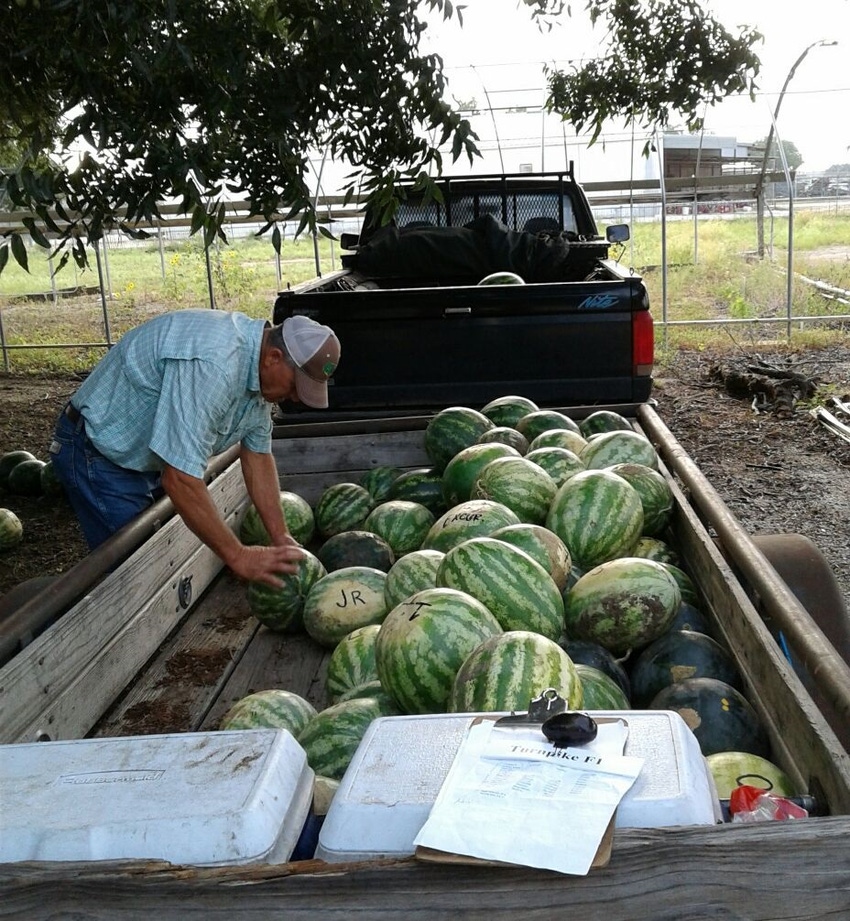August 3, 2017

The Texas A&M AgriLife Extension Service melon trials at the San Antonio Food Bank not only provided produce for those in need, but also important information for Texas agricultural producers.
“We’ve been conducting these trials at the Urban Farm of the San Antonio Food Bank for four years,” said David Rodriguez, Texas A&M AgriLife Extension Service horticulturist, Bexar County. “This year, we planted 16 varieties of watermelon to determine how they would perform.”
According to the food bank website, produce grown at the Urban Farm feeds the hungry and a small portion is sold at local farmers markets operated by the food bank or through its Mobile Mercado — a green grocer on wheels bringing fresh fruits and vegetables to areas of the community with limited access to them.
“This year we harvested at least 10,000 pounds of watermelon and less than 1,000 of that was used to get data for the trials,” said Mike Persyn, Urban Farm manager. “The rest went for distribution to those in need.”
The watermelon varieties were planted April 12 from seedlings grown at Peterson Brothers Nursery in San Antonio.
“Petersons has been collaborating with us on the trials since they began,” Rodriguez said. “We obtain the seeds and Petersons grows the seedlings, which are ready for transplant after about three weeks.”
Dr. Larry Stein, AgriLife Extension horticulturist based in Uvalde, said the information gathered from the trials at the San Antonio Food Bank and other locations is focused on finding useful data to share with agricultural producers in watermelon-producing areas of the state.
“Texas is the nation’s largest watermelon producer,” Stein said. “We also have watermelon trials in the Lower Rio Grande Valley, East Texas and the Panhandle. The data from these trials is compiled and put online for those interested in small- or large-scale production.”
For the most current statewide watermelon trials results, go to http://bit.ly/2gNlWjy.
“The trials at the food bank also provided some useful information about what varieties will grow better in a clay soil,” Persyn said. “Melons are typically grown in areas with more sandy soil, so it was important to find out which ones grow better in the type of soil we have here.”
He said additional trials of honeydew, cantaloupe and tomato by AgriLife Extension have been very helpful in determining what varieties to plant on the Urban Farm. The trial also allowed researchers to test horticultural techniques.
“Dr. Stein also brought a black plastic mulch cover to protect and retain moisture for the watermelons while they grew, and that made a huge difference in the success of this year’s crop,” he said.
Rodriguez said the melon varieties are planted with consumer preferences in mind.
“We know consumers prefer a seedless melon, so 14 of the 16 varieties we planted were seedless,” Rodriguez said. “We also focused on the smaller-size melons most consumers prefer — about 15 to 20 pounds.
He said the recent harvest was timed in conjunction with the optimum window for bringing in a watermelon crop.
“Typically, watermelon sales peak around the Fourth of July, so producers want to make sure they harvest their melons that week or the week before,” he said.
Rodriguez said more than 20 Bexar County Master Gardener volunteers assisted with the food bank harvest.
“We planted wide rows so they had to follow the fruit to the vine it came from so we could identify the variety,” he said. “The watermelons were counted and graded. Then we chose two or three melons of each variety that we felt represented the best sampling for further testing.”
Melons chosen for further testing were weighed and tested for sweetness using a refractometer.
“We also did a consumer taste test to try and determine which of the melons varieties seem to have the greatest consumer appeal,” Stein said.
He said while the taste-test portion of the study is subjective, other data collected is scientifically objective and can be used to help evaluate what varieties home and commercial gardeners would prefer to try.
“The data we collect will help producers identify potential new varieties to plant in the future,” he said. “They will have access to practical information related to the yield and size of the melons, including what portion of the yield produced melons in a particular weight range.”
About the Author(s)
You May Also Like




